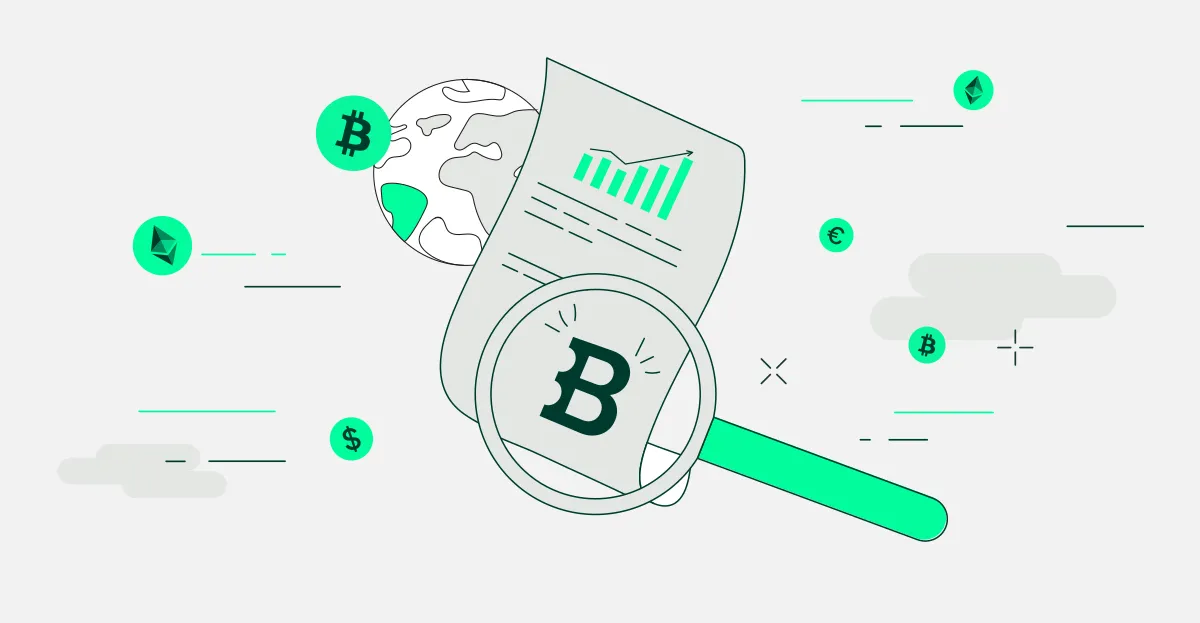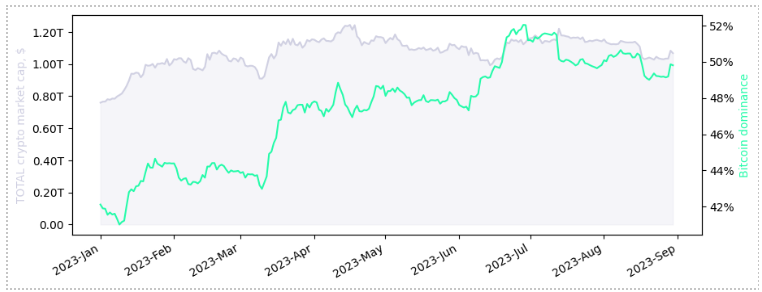Bitstamp Monthly Briefing – August 2023

Each month, we bring you a comprehensive overview of the most significant developments in the world of crypto. From groundbreaking innovations to noteworthy macro events and the performance of crypto assets, we curate all the essential information to keep you up to date, well-informed, and give you a sneak peek at what lies ahead.
Let’s dive in.
Market recap – August 2023
The total crypto market cap decreased by 9.9% MoM and reached $1.03tn at the end of August. Trading volume at leading crypto spot exchanges we track decreased by 4% in the same period, dropping to $298bn.
BTC dominance decreased by 0.7 pp MoM to 49.2%.

Source: Total crypto market cap,Bitcoin dominance
Best performing CMC 100 assets in August
- +60% THORChain (RUNE) - THORChain DEX hit #3 decentralized exchange by trade volume
- +46% Toncoin (TON) - Rumors of possible Binance listing sparked strong buying interest
- +19% SafePal (SFP) - Successfully tested $0.50 resistance level
Worst performing CMC 100 assets in August
- -38% Compound (COMP) - Returned gains from July
- -36% GMX (GMX) - Negative price movement after reports of whales selling
- -35% Pepe (PEPE) - Changes to a multisig wallet and new token transfers led to fears of a "rug pull"
Key macro & crypto events in September 2023
- September 1: US Non-Farm Payrolls, +187K vs. +170K consensus
- September 11-13: Permissionless (Austin)
- September 13: US Inflation Rate
- September 13-14: TOKEN2049 (Singapore)
- September 14: ECB Interest Rate
- September 20: GB Inflation Rate
- September 20: US Fed Interest Rate
- September 20-22: Messari Mainnet (New York)
- September 21: BoE Interest Rate
- September 29: EU Inflation Rate
Friend.Tech: Bridging Social Engagement and Crypto
In the dynamic world of decentralized technology, the recent rise of Friend.Tech has made it a notable player with the potential to revolutionize social interaction and finance. Friend.Tech allows users to buy and sell Keys (recently renamed from Shares) of Twitter influencers, which grants them exclusive access to private group chats. Unlike traditional adaptations, the application reimagines the social stack for the decentralized Web3 era.
Friend.Tech’s pioneering design presents unique monetization opportunities for content creators and engagement opportunities for users. Since its launch in early August, the platform has added over 131,000 users and has seen almost 2 million Keys traded. This has generated over 2,600 ETH in fees for content creators, which has been reportedly concentrated (over 70%) among the platform's top 250 influencers.
Friend.Tech's launch has also notably elevated the activity on Coinbase’s recently unveiled Base Layer 2 blockchain. On August 21, the daily transaction volume on Base surged to its all-time high, nearing 1.4 million transactions. This figure was larger than the volume observed on other prominent L2 networks Arbitrum and Optimism combined.
Total number of transactions registered on-chain

Source:On-Chain Transactions
The launch of the application was not without criticism. Some have labeled the application as speculative, centered around the pricing of influencer Keys and potential for future airdrops. It also faced accusations of a data privacy breach when its API exposed user information such as Twitter handles and crypto wallets; however, Friend.Tech responded by saying the information was already publicly available and hence not leaked. Furthermore, trading of Keys occurs through a bonding curve similar to those used by automated market makers, but the platform’s steep bonding curve makes it extremely expensive for latecomers (after about the first hundred Key holders) to buy Keys.
Despite these criticisms and Friend.Tech’s on-chain activity slump towards the end of August, the project stands at the forefront of integrating social interaction and crypto. Its inventive approach, coupled with rapid adoption, might position the project as a transformative force in decentralized social engagement.
Curve Pool Exploit Sends Shockwaves Through DeFi
Curve Finance pools were targeted by hackers in a re-entrancy attack on July 30, resulting in losses of $73 million and plummeting CRV’s token value well into August. The attackers found a vulnerability in certain versions of the Vyper programing language, one of the languages used for programming Ethereum Virtual Machine (EVM) smart contracts. This issue made some smart contracts vulnerable to re-entrancy attacks which allowed attackers to manipulate balance calculations and steal funds held in various Curve liquidity pools.
Since many other DeFi protocols use Curve pools for liquidity, the attack’s ramifications extended beyond Curve Finance itself. Among the victims were JPEGd's pETH/ETH pool, Metronome's msETH/ETH pool, and Alchemix's alETH/ETH pool. Binance Smart Chain (BSC), another EVM-compatible chain, also fell victim to copycat attacks due to the same vulnerability, resulting in the theft of approximately $73,000 worth of cryptocurrencies across three exploits.
Michael Egorov, the founder of Curve Finance, faced a precarious situation with around $100 million in loans backed by 47% of the circulating CRV tokens. The CRV price plummeted by nearly 39% post-hack, driven by concerns of potential liquidation of Egorov's collateralized loans.
CRV-USD Price Chart

Source: CRV Price Chart
In response to the hack, a consortium of white hat hackers and maximal extractable value (MEV) bot operators helped to recover some of the funds. c0ffeebabe.eth, a white hat hacker, employed an MEV Ethereu,m-arbitrage trading bot to front-run the hackers' actions, ultimately returning 2,879 ETH (approximately $5.4 million) to Curve Finance, according to on-chain data.
On August 3, Curve Finance, Metronome, and Alchemix jointly introduced an initiative to reclaim the stolen funds by offering a 10% bounty, valued at almost $7 million, and pledging no further legal actions or involvement of law enforcement. Remarkably, within 24 hours, the original attacker appeared to accept the bounty offer and initiated the restitution of stolen funds. The hacker restored 4,820.55 alETH (approximately $8.9 million) to the Alchemix Finance team and 1 ETH (approximately $1,800) to the Curve Finance team. On August 5, the attacker completed the restitution process, returning all stolen assets to Alchemix and JPEGd. In total, Curve Finance recovered over 70% of funds, worth about $50 million.
Although the attack primarily targeted Curve Finance, its fallout underscores the risks inherent in the broader DeFi landscape. Despite being a relatively small hack in the crypto world, targeting only 4% of Curve's TVL, it demonstrates how vulnerabilities in a major interconnected DeFi protocol can affect others. It also highlights the challenges in auditing and maintaining diverse software and protocols, where a minor programming flaw can lead to multi-million-dollar losses. As the crypto industry and others digest what happened with Curve, this attack could potentially catalyze more stringent regulatory scrutiny on DeFi protocols, as governments and regulators continue to scrutinize the sector's operations.
Recommended reads
Web3 and Crypto Capitals: A Global Perspective by Sandy Carter via Forbes
The article investigates the explosive growth of Web3 and cryptocurrencies (nearly half a billion people worldwide own digital assets). Decentralized technologies are rapidly evolving, reaching a market cap of $1.3tn, similar to the size of Amazon. Leading this evolution are hubs in Asia, the United States, and the Middle East/Africa.
Understanding Bitcoin's Halving Cycle with Coin Metrics
In 2009, Bitcoin introduced a decentralized digital currency operated by unchanging code. Bitcoin's fixed supply of 21m units and controlled issuance countered conventional approaches. Central to its monetary strategy is the "halving" concept and this report explores halvings, their impact, and current data as Bitcoin approaches its 4th halving next year.
WTF Happened In 2023? By Packy McCormick
This in-depth newsletter highlights stories of optimism in 2023 and argues we’re in a perfect storm of sentiment shift and technological progress that could mark the end of The Great Stagnation and the beginning of The Great Acceleration.
Volatility As a Service by Decentralised
This piece examines why volatility as a service is emerging as a recurring theme across crypto applications and what could be expected from it in the coming years.
No information in this email is intended to provide any personal investment services or advice nor is an investment recommendation. Clients are responsible for making their own investment decisions. Bitstamp accepts no responsibility for any damage and/or loss arising from the use of information provided herein. Past performance is not necessarily an indicator of future results. Please consider your individual position and financial goals before making an independent investment decision.